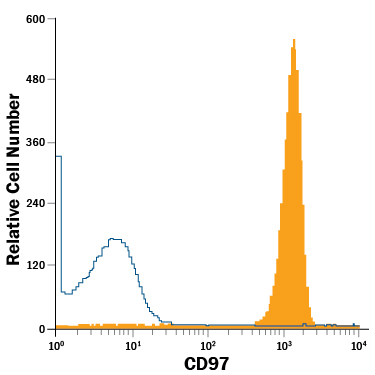Human CD97 APC-conjugated Antibody Summary
Applications
Please Note: Optimal dilutions should be determined by each laboratory for each application. General Protocols are available in the Technical Information section on our website.
Scientific Data
 View Larger
View Larger
Detection of CD97 in Human Neutrophils by Flow Cytometry. Human neutrophils were stained with Mouse Anti-Human CD97 APC-conjugated Monoclonal Antibody (Catalog # FAB2529A, filled histogram) or isotype control antibody (Catalog # IC003A, open histogram). View our protocol for Staining Membrane-associated Proteins.
Reconstitution Calculator
Preparation and Storage
Background: CD97
CD97 is a 95-100 kDa member of a protein group known as the LNB-TM7 protein family that evolved from genes of the secretin receptor superfamily (1-3). Molecules in this family are unique hybrid structures consisting of EGF-like modules coupled to class B G-protein 7-transmembrane (TM) domains by a glycosylated (mucin) stalk. Human CD97 is synthesized as an 835 amino acid (aa) precursor that contains a 20 aa signal sequence, a 532 aa extracellular domain (ECD), a 238 aa “transmembrane” region that includes seven TM segments, and a 45 aa cytoplasmic tail (4). Within the 532 aa ECD, the first 236 aa contains five EGF-like domains, the C-terminal four of which bind calcium, and a juxtamembrane 296 aa RGD-containing mucin stalk (4, 5). The stalk is both glycosylated and proteolytically cleaved (at aa 530) to create a noncovalently linked 65-70 kDa glycosylated extracellular alpha -subunit and a 28 kDa 7-TM membrane-bound beta -subunit (4). There are two known alternate splice forms in human. Isoform # 1 contains four EGF-like domains (domain # 1, 2, 3 and 5), while isoform # 2 contains three EGF-like domains (domain # 1, 2 and 5) (1, 4, 6). The ECD in isoform 1 is 60 kDa in size, while the ECD in isoform 2 is 55 kDa in size (native molecular weight). The five EGF-like domain region in human is 55% aa identical to that in mouse. Cells known to express CD97 include monocytes, macrophages, T cells, select B cells, dendritic cells and, potentially, vascular and visceral smooth muscle cells (1, 7). There are at least two ligands for CD97. One is chrondroitin sulfate that binds only to the full-length (five domain) form of CD97. Binding is dependent on the presence of EGF-like domain # 4 (3). The second ligand for CD97 is CD55, a GPI-linked cell surface molecule with short consensus repeats that regulates complement activation on cell surfaces (1, 5, 7). CD97 EGF-like domains # 1 and 2 bind CD55 while domain # 5 stabilizes the CD97 molecule. The shortest CD97 isoform shows the strongest binding to CD55 (7, 8).
- McKnight, A.J. and S. Gordon (1998) J. Leukoc. Biol. 63:271.
- Stacey, M. et al. (2000) Trends Biochem. Sci. 25:284.
- Stacey, M. et al. (2003) Blood 102:2916.
- Gray, J.X. et al. (1996) J. Immunol. 157:5438.
- Lin, H-H. et al. (2001) J. Biol. Chem. 276:24160.
- Hamann, J. et al. (1995) J. Immunol. 155:1942.
- Jaspars, L.H. et al. (2001) Tissue Antigens 57:325.
- Hamann, J. et al. (1996) J. Exp. Med. 184:1185.
Product Datasheets
Citation for Human CD97 APC-conjugated Antibody
R&D Systems personnel manually curate a database that contains references using R&D Systems products. The data collected includes not only links to publications in PubMed, but also provides information about sample types, species, and experimental conditions.
1 Citation: Showing 1 - 1
-
Emerging Bordetella pertussis Strains Induce Enhanced Signaling of Human Pattern Recognition Receptors TLR2, NOD2 and Secretion of IL-10 by Dendritic Cells
Authors: ES Hovingh, M van Gent, HJ Hamstra, M Demkes, FR Mooi, E Pinelli
PLoS ONE, 2017-01-11;12(1):e0170027.
Species: Human
Sample Types: Whole Cells
Applications: Flow Cytometry
FAQs
No product specific FAQs exist for this product, however you may
View all Antibody FAQsReviews for Human CD97 APC-conjugated Antibody
There are currently no reviews for this product. Be the first to review Human CD97 APC-conjugated Antibody and earn rewards!
Have you used Human CD97 APC-conjugated Antibody?
Submit a review and receive an Amazon gift card.
$25/€18/£15/$25CAN/¥75 Yuan/¥2500 Yen for a review with an image
$10/€7/£6/$10 CAD/¥70 Yuan/¥1110 Yen for a review without an image

